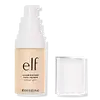What's inside
What's inside
 Key Ingredients
Key Ingredients

 Benefits
Benefits

No benefits
 Concerns
Concerns

 Ingredients Side-by-side
Ingredients Side-by-side

Cyclopentasiloxane
EmollientDimethicone
EmollientDimethicone/Vinyl Dimethicone Crosspolymer
Skin ConditioningCyclohexasiloxane
EmollientSilica
AbrasivePolymethylsilsesquioxane
Dimethicone/PEG-10/15 Crosspolymer
Parfum
MaskingPolymethyl Methacrylate
Water
Skin ConditioningMineral Salts
Skin ConditioningTriethoxycaprylylsilane
Propanediol
SolventMentha Arvensis Leaf Extract
Masking1,2-Hexanediol
Skin ConditioningPhenoxyethanol
PreservativeOpuntia Coccinellifera Fruit Extract
Skin ConditioningAluminum Hydroxide
EmollientCI 77891
Cosmetic ColorantSodium Citrate
BufferingOrchid Extract
Skin ConditioningCamellia Sinensis Leaf Extract
AntimicrobialCI 77491
Cosmetic ColorantDiospyros Kaki Fruit Extract
Skin ConditioningCI 77492
Cosmetic ColorantCI 77499
Cosmetic ColorantCitrus Unshiu Peel Extract
MaskingEthylhexylglycerin
Skin ConditioningMica
Cosmetic ColorantCamellia Japonica Leaf Extract
Skin ConditioningTitanium Dioxide
Cosmetic ColorantLinalool
PerfumingButylene Glycol
HumectantLimonene
PerfumingTocopherol
AntioxidantDipropylene Glycol
HumectantCyclopentasiloxane, Dimethicone, Dimethicone/Vinyl Dimethicone Crosspolymer, Cyclohexasiloxane, Silica, Polymethylsilsesquioxane, Dimethicone/PEG-10/15 Crosspolymer, Parfum, Polymethyl Methacrylate, Water, Mineral Salts, Triethoxycaprylylsilane, Propanediol, Mentha Arvensis Leaf Extract, 1,2-Hexanediol, Phenoxyethanol, Opuntia Coccinellifera Fruit Extract, Aluminum Hydroxide, CI 77891, Sodium Citrate, Orchid Extract, Camellia Sinensis Leaf Extract, CI 77491, Diospyros Kaki Fruit Extract, CI 77492, CI 77499, Citrus Unshiu Peel Extract, Ethylhexylglycerin, Mica, Camellia Japonica Leaf Extract, Titanium Dioxide, Linalool, Butylene Glycol, Limonene, Tocopherol, Dipropylene Glycol
Cyclopentasiloxane
EmollientCyclohexasiloxane
EmollientDimethicone Crosspolymer
Emulsion StabilisingDimethicone
EmollientDimethicone/Vinyl Dimethicone Crosspolymer
Skin ConditioningSilica
AbrasiveSilica Dimethyl Silylate
EmollientPhenoxyethanol
PreservativeMica
Cosmetic ColorantCI 77891
Cosmetic ColorantIron Oxides
CI 77742
Cosmetic ColorantCI 16035
Cosmetic ColorantCI 42090
Cosmetic ColorantCI 77007
Cosmetic ColorantCI 77288
Cosmetic ColorantCI 77820
Cosmetic ColorantIngredients Explained
These ingredients are found in both products.
Ingredients higher up in an ingredient list are typically present in a larger amount.
Ci 77891 is a white pigment from Titanium dioxide. It is naturally found in minerals such as rutile and ilmenite.
It's main function is to add a white color to cosmetics. It can also be mixed with other colors to create different shades.
Ci 77891 is commonly found in sunscreens due to its ability to block UV rays.
Learn more about CI 77891Cyclohexasiloxane is a type of silicone more commonly known as D6. It is an emollient and solvent.
Cyclohexasiloxane is used to evenly distribute ingredients throughout the product. When applied to the skin, Cyclohexasiloxane evaporates and leaves behind a silky feel.
As an emollient, it can help the skin feel soft and hydrated. It is also used to reduce frizz in hair products.
Learn more about CyclohexasiloxaneCyclopentasiloxane, or D5, is a silicone used to improve texture of products and trap moisture.
D5 is considered lightweight and volatile. Volatile means it evaporates quickly after application. Once evaporated, D5 leaves a thin barrier that helps keep skin hydrated.
It is also an emollient. Emollients help soften the skin and prevent water loss. Silicones create a silky texture in products. D5 helps other ingredients become more spreadable.
Studies show D5 is safe to use in skincare products. We recommend speaking with a skincare professional if you have concerns.
Learn more about CyclopentasiloxaneDimethicone is a type of synthetic silicone created from natural materials such as quartz.
What it does:
Dimethicone comes in different viscosities:
Depending on the viscosity, dimethicone has different properties.
Ingredients lists don't always show which type is used, so we recommend reaching out to the brand if you have questions about the viscosity.
This ingredient is unlikely to cause irritation because it does not get absorbed into skin. However, people with silicone allergies should be careful about using this ingredient.
Note: Dimethicone may contribute to pilling. This is because it is not oil or water soluble, so pilling may occur when layered with products. When mixed with heavy oils in a formula, the outcome is also quite greasy.
Learn more about DimethiconeThis ingredient is a silicone used to improve the texture of products and absorb oil. It does not get absorbed into the skin.
Like other silicones, Dimethicone/Vinyl Dimethicone Crosspolymer helps condition the skin by creating a barrier. In this sense, it can act as an emollient and trap moisture in.
This ingredient is a type of elastomer.
Learn more about Dimethicone/Vinyl Dimethicone CrosspolymerMica is a naturally occurring mineral used to add shimmer and color in cosmetics. It can also help improve the texture of a product or give it an opaque, white/silver color.
Serecite is the name for very fine but ragged grains of mica.
This ingredient is often coated with metal oxides like titanium dioxide. Trace amounts of heavy metals may be found in mica, but these metals are not harmful in our personal products.
Mica has been used since prehistoric times throughout the world. Ancient Egyptian, Indian, Greek, Roman, Aztec, and Chinese civilizations have used mica.
Learn more about MicaPhenoxyethanol is a preservative that has germicide, antimicrobial, and aromatic properties. Studies show that phenoxyethanol can prevent microbial growth. By itself, it has a scent that is similar to that of a rose.
It's often used in formulations along with Caprylyl Glycol to preserve the shelf life of products.
Silica, also known as silicon dioxide, is a naturally occurring mineral. It is used as a fine, spherical, and porous powder in cosmetics.
Though it has exfoliant properties, the function of silica varies depending on the product.
The unique structure of silica enhances the spreadability and adds smoothness, making it a great texture enhancer.
It is also used as an active carrier, emulsifier, and mattifier due to its ability to absorb excess oil.
In some products, tiny microneedles called spicules are made from silica or hydrolyzed sponge. When you rub them in, they lightly polish away dead skin layers and enhance the penetration of active ingredients.
Learn more about Silica